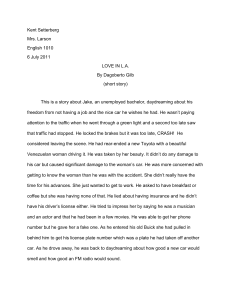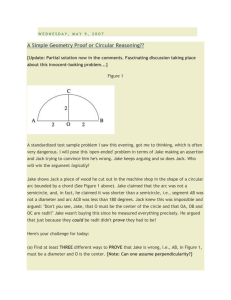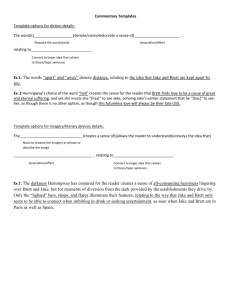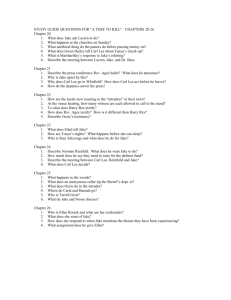Maryland State Department of Education Academy of Health
advertisement
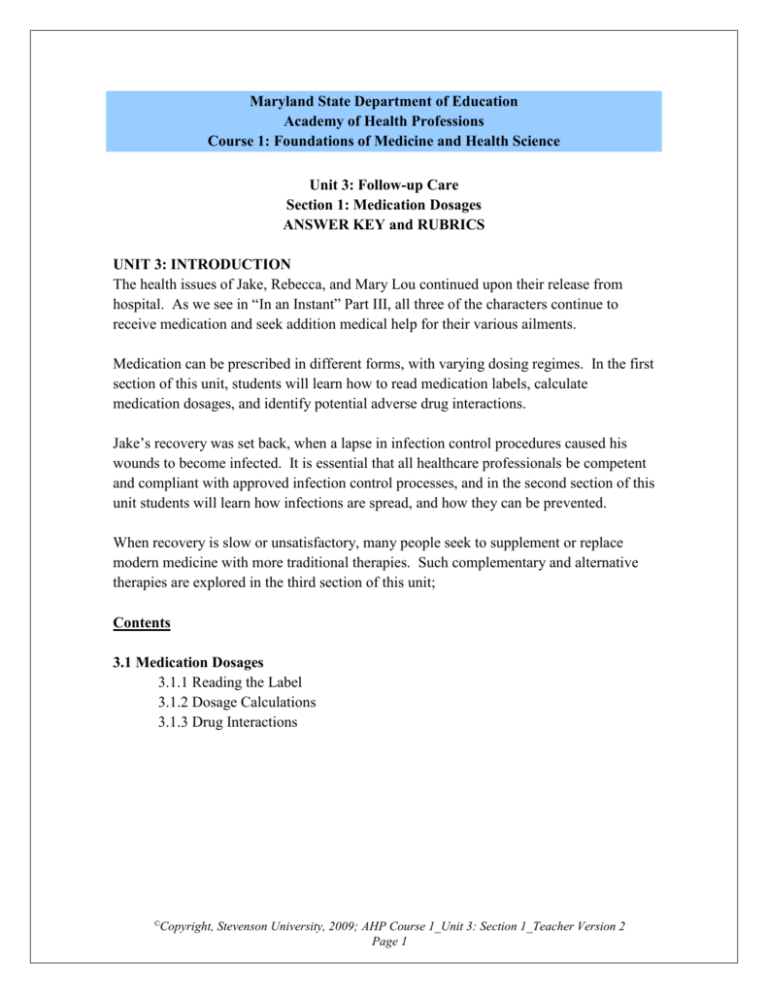
Maryland State Department of Education Academy of Health Professions Course 1: Foundations of Medicine and Health Science Unit 3: Follow-up Care Section 1: Medication Dosages ANSWER KEY and RUBRICS UNIT 3: INTRODUCTION The health issues of Jake, Rebecca, and Mary Lou continued upon their release from hospital. As we see in “In an Instant” Part III, all three of the characters continue to receive medication and seek addition medical help for their various ailments. Medication can be prescribed in different forms, with varying dosing regimes. In the first section of this unit, students will learn how to read medication labels, calculate medication dosages, and identify potential adverse drug interactions. Jake’s recovery was set back, when a lapse in infection control procedures caused his wounds to become infected. It is essential that all healthcare professionals be competent and compliant with approved infection control processes, and in the second section of this unit students will learn how infections are spread, and how they can be prevented. When recovery is slow or unsatisfactory, many people seek to supplement or replace modern medicine with more traditional therapies. Such complementary and alternative therapies are explored in the third section of this unit; Contents 3.1 Medication Dosages 3.1.1 Reading the Label 3.1.2 Dosage Calculations 3.1.3 Drug Interactions © Copyright, Stevenson University, 2009; AHP Course 1_Unit 3: Section 1_Teacher Version 2 Page 1 Name:________________________ 3.1.1 WORKSHEET 17: INTERPRETING DRUG LABELS – ANSWER KEY Drug 1 1. National Drug Code: NDC 63323-262-01 926201 2. Administration route: Intravenous or subcutaneous 3. Supply dosage: 5,000 USP/ml 4. Total volume of the drug container: © . . . 1ml . Copyright, Stevenson University, 2009; AHP Course 1_Unit 3: Section 1_Teacher Version 2 Page 2 Drug 2 1. National Drug Code: NDC 10019-178-44 2. Administration route: Subcutaneous, intramuscular, or intravenous 3. Supply dosage: 10 mg/ml . . 4. Total volume of the drug container: © . 1 ml . Copyright, Stevenson University, 2009; AHP Course 1_Unit 3: Section 1_Teacher Version 2 Page 3 Drug 3 1. Brand name: 2. Generic name: Kefzol . cefazolin sodium 3. Instructions for reconstitution: . Add 2 ml of sterile water or 0.9% Sodium chloride 4. Concentration after reconstitution: 225 mg/ml 5. Storage requirements before reconstitution: 6. Storage requirements after reconstitution: © . Room temperature (59 – 86 °F) . Refrigeration required. Copyright, Stevenson University, 2009; AHP Course 1_Unit 3: Section 1_Teacher Version 2 Page 4 . Name:____________________________ 3.1.2 WORKSHEET 18: DOSAGE CALCULATIONS – ANSWER KEY PART I: MEDICATION DOSAGES 1. Rebecca was prescribed 5 mg of Prozac daily to help her with the post-traumatic stress that she developed following Jake’s accident. Prozac was available as 10mg scored tablets. How many should Rebecca take daily? Using the formula method: D = 5 mg H = 10 mg and Q = 1 tablet. Calculate the dosage: 5 mg 1 tablet 0.5 tablet 10 mg Rebecca should take 0.5 tablets daily. 2. Mary-Lou was prescribed 0.5 mg of Xanax every 3 hours to help her with her anxiety disorder. Xanax is available as 0.25 mg tablets. Calculate the number of tablets that Mary-Lou should take every 3 hours. Note that 0.5 2 0.25 . Mary-Lou should take 2 tablets daily. 3. When admitted to the Emergency room, Jake was given morphine to manage his pain. The prescribe dosage was 2 mg every 4 hours via the IV route. Using the information from the drug label below determine the following; a. Is this medication is suitable for this route of administration? Yes _ b. Are there any special handling requirements? Protect from light . c. Calculate the amount of morphine which must be added to Jake’s IV. Ratio-Proportion Method: 1. Set up ratios: 10 mg: 1 ml = 2mg : X ml 2. Multiply means and extremes: (10 mg)(X ml) = (1 ml)(2mg) ( 1ml )( 2 mg ) 3. Divide: X ml 0.2 ml 10 mg 4. Adminster 0.2 ml © Copyright, Stevenson University, 2009; AHP Course 1_Unit 3: Section 1_Teacher Version 2 Page 5 Formula Method: 1. D = 2 mg, H = 10 mg, and Q = 1 ml 2. Calculate the dosage: 2 mg 1ml 0.2 ml 10 mg The amount of morphine to be added to Jake’s IV is 0.2 ml. 4. Jake’s road rash later becomes infected, and requires antibiotic treatment. He is prescribed 1 g of Ancef (Cefazolin) every 8 hours via IV. Using the information from the drug label below determine the following; a. How must this medication be prepared prior to administration? in 2 ml of sterile water or 0.9% Sodium chloride . b. What is the concentration of the medication after preparation? It should be dissolved 225 mg/ml . c. How much of the Ancef preparation should be added to Jake’s IV every 8 hours? © Copyright, Stevenson University, 2009; AHP Course 1_Unit 3: Section 1_Teacher Version 2 Page 6 Jake was prescribed 1 g but the concentration is in mg so convert the grams to milligrams: 1g = 1000 mg Ratio-Proportion Method: 1. Set up ratios: 225 mg : 1 ml = 1000 mg : X ml 2. Multiply means and extremes: 225 mg x X ml = 1 ml x 1000mg 1ml 1000 mg 3. Divide: X ml 4.44 ml 225 mg 4. Adminster 4.4 ml Formula Method: 1. D = 1000 mg, H = 225 mg, Q = 1 ml 1000 mg 2. Calculate the dosage: 1ml 4.44 ml 225 mg Jake should receive 4.4 ml via IV every 8 hours. (Note: you roundup to the nearest tenths of a ml as you cannot measure hundreds of a ml using a syringe). 5. Jake was given Heparin to slow the clotting time of his blood as therapy for the blood clot in his leg. He was given an initial bolus of Heparin, which was administered as 80 units/ kg of body weight via an IV. Jake weighs 160 lbs. Using the information on the label below determine the following: a. How much Heparin should be added to Jake’s IV? First convert the units of Jake’s weight to kg: 1. Jake weighs 160 lbs. and 1 kg = 2.2 lbs © Copyright, Stevenson University, 2009; AHP Course 1_Unit 3: Section 1_Teacher Version 2 Page 7 160 lb 1kg 160 lb 72.7 lb 1 2.2lb Second, determine the dose based upon Jake’s weight: 1. Heparin is administered at 80 units/kg. Jake weighs 72.7 kg 2. Jake’s Dose = (72.2 kg) (80 units/kg) = 5,816 units 2. Third, calculate dose: Ratio-Proportion Method: 1. Set up ratios: 5,000 units : 1 ml= 5,816 units: X ml 2. Multiply means and extremes: (5,000 units)(Xml) = (1 ml)(5,816 units) ( 1ml )( 5816 units ) 3. Divide: X ml 1.16 ml (round to 1.2 ml) 5000 units 4. Adminster 1.2 ml Formula Method: 1. D = 5816 units, H = 5000 units, Q = 1 ml 5816 units 2. Calculate the dosage: 1ml 1.16 ml (round to 1.2 ml) 5000 units Jake should receive an initial bolus of © 1.2 ml of Heparin via IV. Copyright, Stevenson University, 2009; AHP Course 1_Unit 3: Section 1_Teacher Version 2 Page 8 6. After the initial bolus, Jake is to receive 18 units of Heparin per kg of body weight infused over an hour. For this medication, Heparin at a concentration of 25,000 units/500 ml will be used. a. Calculate the volume of Heparin to be infused over a period of an hour. We already know that Jake weighs 160 lbs, which is 72.7 kg. Determine the dose based upon Jake’s weight: 1. Heparin is to be administered at 18 units/kg. Jake weighs 72.7 kg 2. Jake’s Dose = (72.2 kg)(18 units/kg) = 1,309 units Calculate dosage: Ratio-Proportion Method: 1. Set up ratios: 25,000 units : 500 ml= 1,309 units : X ml 2. Multiply means and extremes: (25,000 units)(Xml) =(500 ml)(1,309 units) ( 500ml )( 1309 units ) 3. Divide: X ml 26.18 ml (round to 26 ml) 25000 units Administer 26 ml Formula Method: 1. D = 1309 units, H = 25,000 units, Q = 500 ml 2. Calculate the dosage: Jake should receive © 26 1309 units 500 ml 26.18 ml (round to 26 ml) 25000 units ml of Heparin per hour. Copyright, Stevenson University, 2009; AHP Course 1_Unit 3: Section 1_Teacher Version 2 Page 9 PART II: INTRAVENOUS CALCULATIONS The flow rate of Jake’s IV must be adjusted so that it will deliver the amount of Heparin calculated in question 6 of Part I per hour. Therefore calculations must be performed to determine the flow rate of the IV required to deliver the medication at the correct rate. The flow rate of an IV is determined by the type of tubing used, which is as follows: Macrodrop tubing: delivers 10, 15, or 20 drops (gtts)/ml Microdrip tubing: delivers 60 drops (gtts)/ml In order to calculate the IV flow the following formula is used: (ml to be infused)(drop rate (gtts/ml)) = drops/min to be administered infusion time (mins) Example 1: Ordered 1000ml of D5W to infuse over 6 hours The drop factor of the tubing is 10 gtts/ml How many gtts/min should be infused? 1000ml x 10gtts/ml = 360 min 10,000 gtts 360 min = 27.8 gtts/min = 28 gtts/min (rounded to nearest drop) 1. Using the above method, calculate the flow rate that Jake’s IV must be set at to deliver the 18 units of Heparin per kg of body weight infused over an hour using tubing with a drop rate of 10 gtts/ml. Note, the volume of Heparin was calculated in question 6 of Part I. ml to be infused x drop rate (gtts/ml) = drops/min to be administered (round to the nearest ml) infusion time (mins) 1. We previously calculated that Jake should receive 26 ml of Heparin per hour (based upon his body weight) ( 26 ml )( 10 gtts/ml ) 4.33 gtts/min ( round to 4gtts/min) 60 min 2. Jake’s IV should be set at © 4 gtts/min Copyright, Stevenson University, 2009; AHP Course 1_Unit 3: Section 1_Teacher Version 2 Page 10 2. Jake was also given Solu-medrol (generic name methylPrednisolone Sodium Succinate) to treat his spinal cord injury. a. Using the information on the label, describe how this medication is prepared, and the concentration of the prepared medication. The Solu-medrol is reconstituted using 16 ml of sterile water. The prepared concentration is 62.5 mg/ml This was given by IV in two different doses. Using the information on the drug label, and Jake’s weight of 160 lbs, calculate the volume of Solu-medrol and the IV flow rate required to administer the following doses: b. Jake was initially given 30mg/kg of Solu-medrol intravenously over 15 minutes using tubing with a drop rate of 10 gtts/min. First, determine the dose based upon Jake’s weight: 1. Jake weighs 72.7 kg 2. Solu-medrol is administered at 30 mg/kg 2. Jake’s Dose = (72.7 kg)(30 mg/kg) = 2,181 mg © Copyright, Stevenson University, 2009; AHP Course 1_Unit 3: Section 1_Teacher Version 2 Page 11 Second, calculate dosage: Ratio-Proportion Method: 1. Set up ratios: 62.5 mg: 1ml = 2,181 mg: Xml 2. Multiply means and extremes: (62.5 mg)( Xml) = (1 ml)(2,181 mg) ( 1ml )( 2181mg ) 3. Divide: Xml 34.896ml (round to 35 ml) 62.5mg 4. Administer 35 ml Formula Method: 1. D = 2181 mg, H = 62.5 mg, Q = 1 ml 2. Calculate the dosage: 2181 mg 1ml 34.896 ml (round to 35 ml) 62.5 mg Third, calculate IV drop rate to deliver 35 ml in 15 mins. ml to be infused x drop rate (gtts/ml) = drops/min to be administered infusion time (mins) 1. We calculated that Jake should receive 35 ml of Solu-medrol in 15 mins ( 35 ml )( 10 gtts/ml ) 23.3 gtts/min (round to 23 gtts/min) 15 min 2. Jake should receive 35 ml of Solu-medrol via an IV with a flow rate of 23 gtts/min c. This was followed with 5.4 mg/kg/hr of Solu-medrol infused over 23 hours, again using tubing with a drop rate of 10 gtts/min. First, determine the dose based upon Jake’s weight: 1. Jake weighs 72.7 kg 2. Solu-medrol is to be administered at 5.4 mg/kg each hour 2. Jake’s Dose = (72.7kg)(5.4 mg/kg) = 392.58 mg/hour (round to 393 mg/hour) Second, calculate dosage: Ratio-Proportion Method: 1. Set up ratios: 62.5 mg: 1ml = 393mg/hour: Xml 2. Multiply means and extremes: (62.5 mg)( Xml) = (1 ml)(393 mg/hour) © Copyright, Stevenson University, 2009; AHP Course 1_Unit 3: Section 1_Teacher Version 2 Page 12 3. Divide: Xml ( 1ml )( 393 mg/hour ) 6.288 ml/hour ( round to 6.3 ml / hour ) 62.5mg 4. Administer 6.3 ml/hour Formula Method: 1. D = 393 mg, H = 62.5 mg, Q = 1 ml 2. Calculate the dosage: 393 mg / hour 1ml 6.288 ml / hour ( round to 6.3 ml / hour ) 62.5 mg Third, calculate IV drop rate to deliver 6.3 ml in 1 hour. (ml to be infused)(drop rate (gtts/ml)) = drops/min to be administered infusion time (mins) 1. We calculated that Jake should receive 6.3 ml of Solu-medrol in 60 mins ( 6.3 ml )( 10 gtts/ml ) 2. 1.05 gtts/min ( round to 1.0 gtt/min ) 60 min Jake should receive 6.3 ml/hour of Solu-medrol via an IV with a flow rate of 1.0 gtt/min © Copyright, Stevenson University, 2009; AHP Course 1_Unit 3: Section 1_Teacher Version 2 Page 13 Name:________________________ 3.1.3 WORKSHEET 19: DRUG INTERACTIONS – ANSWER KEY DRUG 1 DRUG 2 SIDE EFFECTS © LABEL INFORMATION Copyright, Stevenson University, 2009; AHP Course 1_Unit 3: Section 1_Teacher Version 2 Page 14 Name:_____________________ Drug Interaction Worksheet Questions 1. Drug interaction: Drug 1:_____________________ Drug 2:______________________ 2. Warning information on the label:____________________________________________ ________________________________________________________________________ 3. What words do you recognize in this information?_______________________________ ________________________________________________________________________ 4. What words do you not understand?___________________________________________ ________________________________________________________________________ 5. Using your textbook or online resources, find out the meaning of the words listed in question 4.______________________________________________________________ _______________________________________________________________________ 6. Putting together the information from question 3 and 5, explain the full meaning of the warning information.______________________________________________________ ________________________________________________________________________ ________________________________________________________________________ 7. Before this exercise, would you have understood that the information contained in the warning indicated a possible interaction between these two drugs? Explain why or why not.____________________________________________________________________ _______________________________________________________________________ 8. Can you think of a clearer way to convey this information?_______________________ _______________________________________________________________________ 9. What role do you think that the following health professionals play in communicating information regarding drug interactions: a. Physician:_______________________________________________________ ___________________________________________________________________ b. Pharmacist:______________________________________________________ ______________________________________________________________________ 10. Identify some resources which may have helped Marylou identify her drug interaction. __________________________________________________________________________ © Copyright, Stevenson University, 2009; AHP Course 1_Unit 3: Section 1_Teacher Version 2 Page 15

